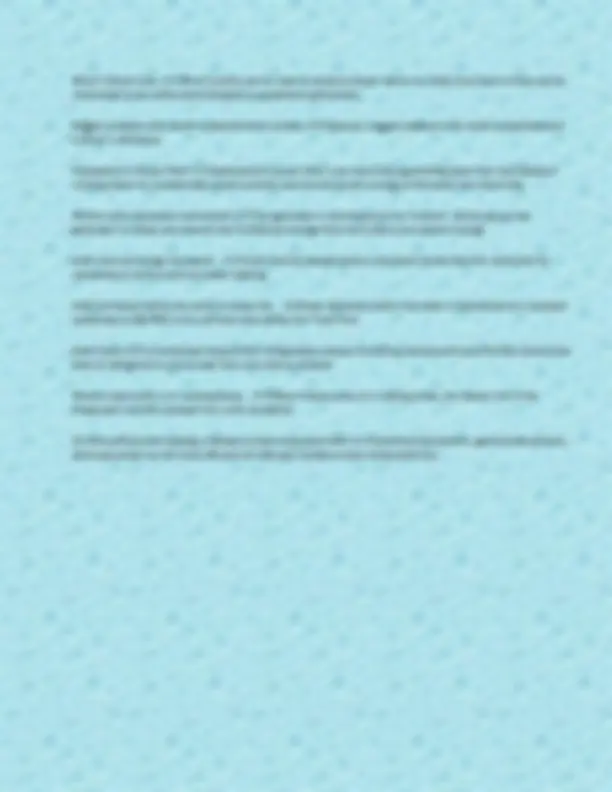



Study with the several resources on Docsity

Earn points by helping other students or get them with a premium plan


Prepare for your exams
Study with the several resources on Docsity

Earn points to download
Earn points by helping other students or get them with a premium plan
Community
Ask the community for help and clear up your study doubts
Discover the best universities in your country according to Docsity users
Free resources
Download our free guides on studying techniques, anxiety management strategies, and thesis advice from Docsity tutors
A basic overview of power generation, distribution, and smart grid systems. It covers key concepts such as potential energy, energy efficiency, alternating current (ac) transmission, microgrids, and smart grid technology. The document also explores renewable energy sources like solar, wind, and geothermal, and discusses the benefits and challenges of hybrid ac/dc microgrids. It is suitable for students and professionals seeking an introductory understanding of these topics.
Typology: Quizzes
1 / 3

This page cannot be seen from the preview
Don't miss anything!


Potential Energy ✔✔Stored energy due to position, chemical state, or physical condition. Benefit of Three-Phase motors? ✔✔Although three-phase motors use the largest amount of electricity of all motors, they are also the most energy efficient. Why input energy does not contribute to output energy? ✔✔However some input energy does not contribute to output energy because it is lost through friction and heat. Energy Efficiency Formula ✔✔Energy Efficiency (%) = Energy Output (W) / Energy Input (W) * 100% Electricity ✔✔a form of energy where electrons move from the outer shell of one atom to the outer shell of another atom when electromotive force (EMF) is applied to a material. The transmission and distribution loss percentage? ✔✔The transmission and distribution of electricity typically results in losses of as much as 6% to 7% of the generated electrical power annually, mostly attributed to heat. Alternating Current (AC) Transmission ✔✔Alternating Current (AC) electricity has long been the primary source of generated electricity that is transmitted through transmission lines. Alternating Current (AC) ✔✔Current that reverses or alternates it direction of flow at regular intervals. AC is typically transmitted at high voltages to allow for transmission at long distances. Distribution lines distribute power at... ✔✔Distribution lines distribute power at a relatively lower voltage than transmission lines, which allows for smaller equipment and smaller footprint to distribute power throughout a residential area. (Distribution < Transmission) What helps new source of power generation? ✔✔To help integrate and control these sources of power generation, the older, traditional distribution systems are being upgraded through the addition of HVDC transmission lines and new electronic monitoring equipment. Microgrid ✔✔a small local electrical network or grid that can operate completely separate from the main electrical grid. What does Back-up generators do? ✔✔Back-up generators normally supply power only to critical loads that must have power during a power outage. Smart Grid ✔✔an electrical grid in which electricity is delivered and monitored from a power source to an end user. Power Quality ✔✔The condition of incoming power to a load. Peaker Power Plant ✔✔a back-up power plant that is reserves to run only during times of increased demand.
Smart Grid Tech can also? ✔✔Smart grid technology can also be used to gather information from remote sensors and use energy harvesting to power these sensors remotely. Electronic devices conversion losses ✔✔Electronic devices use DC and must convert the available AC into DC through adapters, resulting losses of as much as 20%. Smart Home ✔✔a residence that contains equipment, appliances, and software that are designed to provide security, energy management, and convenience. Energy Losses in AC System (EX) ✔✔EX: a solar array may not provide the desired energy efficiency due to the AC/DC conversion losses. Energy Losses in AC System (Percentage Loss) ✔✔However, there is a 20% energy loss due to the DC-to-AC conversion process. Consideration for Hybrid AC/DC Microgrid ✔✔The major reason for homeowners to consider a hybrid AC/DC microgrid is for increased energy efficiency. DC power system provide... ✔✔This type of system also provides the homeowner with a choice of either storing excess power or selling it back to the utility. High Power USB Cable Transfer (W) ✔✔High power USB cable can transfer up to 100 W of DC power. Direct DC Connection Downside ✔✔A downside for direction DC connections is that not all digital or electronic control device are 100% efficient. Prevention of Small Leakage Current ✔✔Some devices have internal switching capability to prevent small leakage current. (Called Phantom Power) Wind turbine systems and solar PV systems must be installed per? ✔✔Wind turbine systems and solar PV systems must be installed per all National Electrical Code (NEC) "requirements" and must be equipped with proper disconnects. renewable energy ✔✔Energy from self-replenishing sources. EX: sun, water, wind, solar thermal & geothermal energy. Photovoltaics (PV) ✔✔solar energy technology that uses the unique properties of semiconductors to convert solar radiation in electricity. Photovoltaics (PV) systems uses... ✔✔Photovoltaics (PV) systems uses silicon wafers, called "cells," that are sensitive to light and produce a small direct current when exposed to light. Wind Turbine ✔✔a power generation system that converts the kinetic energy of wind into mechanical energy, which used to rotate a generator that produces electrical energy.